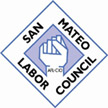Dave Pine Elected as President of County Board of Supervisors
Supervisor Dave Pine was elected president of the San Mateo County Board of Supervisors during the Board’s first meeting of 2014. Pine was elected in May 2011 to represent District 1, which includes Burlingame, Hillsborough, parts of San Bruno and South San Francisco and the unincorporated San Mateo Highlands and Burlingame Hills neighborhoods. He made a brief speech at his swearing-in as Board president in which he called for “more risk taking, innovation and efficiency in 2014.”
Pine commented that, “for the most part, the great recession is in the rear view mirror,” and pointed to a low unemployment rate—officially around 5 percent—and high median family income as signs of good news in San Mateo County. Pine also noted that, “We are seeing robust business growth, particularly in the tech sector. This is all good news, but there is another side of San Mateo County; in this county of great wealth, many struggle due to the extremely high cost of living. ” Supervisor Pine cited a recent Stanford University study that found that as many as 136,000 San Mateo County residents live in poverty when high housing costs are taken into account.
He noted that one in seven residents receive medical or other human services assistance from the County government and one in three children in public schools qualify for free or reduced school lunches. “ The dark side of the healthy real estate market is that it is becoming more and more difficult to pay rent or the mortgage when the median price for a single family home is just under $1 million and the median monthly rent for a one-bedroom apartment stands at about $2,000,” he said. Additionally, there are as many as 1,300 homeless people living on county streets or in makeshift encampments or vehicles.
Pine commented that the booming economy also creates traffic jams and problems for commuters.
He laid out what he called “new year’s resolutions” for the County in 2014 as basic themes for guiding the work of County government. The four areas Pine highlighted are investing in prevention and early intervention, fiscal discipline, government efficiency and innovation, and bringing passion to the work of government. Pine suggested investing funds from the County’s Measure A sales tax in funding for people in crisis—including the homeless population, people suffering from mental illness and the incarcerated—as well as for preschool programs for three-year old children.
Some of the fiscal measures Pine proposed include paying down pension obligations and lowering operating costs by investing in energy efficiency in County buildings. Pine noted that before the economic downturn the County had 5,625 employees and now has about 5,140. He said the County should be cautious in increasing the number of County employees back to pre-recession levels.
As part of his call for more innovation and risk taking, Pine noted that in his experience in the private sector in the high tech field, “the culture, pace of change and decision making process was, shall we say, more action oriented there,” but also acknowledged that, “it is misguided to assert that government should be run like a business.” Pine said that, “County government is responsible for implementing the social safety net no matter how difficult or costly that may be, and the value of what we do cannot be easily quantified in dollars and cents. But that said, there is plenty of room for innovation in government .”
One innovation the Supervisor pointed to was the development of smart phone applications by Code for America volunteers to simplify the process for county residents to access CalFresh food stamps. Pine also said County government is looking for the right mix of permanent employees, short term workers, contractors and volunteers for delivering services through the County’s “Agile Workforce Initiative” to increase efficiency.
The “Agile Organization” concept has been challenged by the unions representing County workers because it can lead to contracting out of work done by unionized employees. AFSCME Local 829 Business Agent Nadia Bledsoe said that the original proposal was to introduce short-term outside contractors into the general county workforce. AFSCME and SEIU fought the imposition of that concept and instead negotiated limits and conditions on their use. Since the two unions already represent temporary workers, these term employees enjoy wages and benefits bargained by the unions. AFSCME and SEIU secured a 3 percent salary increase for both temporary and permanent employees through negotiations of the Extra Help contract in 2013. Bledsoe noted that Supervisor Pine was among the Board members who followed the process closely to ensure the unions had adequate input into how the changes are implemented.
Feb. 2014
|





